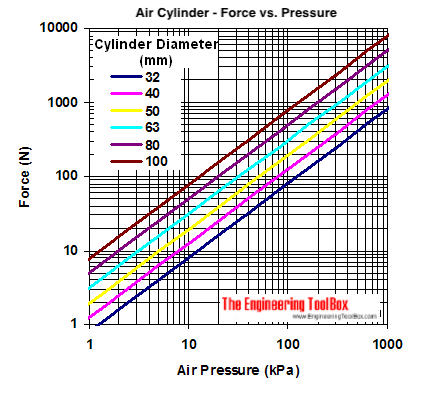Pneumatic Cylinder - Excerted Force vs. Pressure
Force excerted by pneumatic air cylinders vs. air pressure cylinder size - online calculator.
Single Acting Cylinder

The force exerted by a single acting pneumatic cylinder can be expressed as
F = p A
= p π d2 / 4 (1)
where
F = force exerted (N)
p = gauge pressure (N/m2, Pa)
A = full bore area (m2)
d = full bore piston diameter (m)
Single Acting Cylinder Calculator - Output Stroke
Calculate Force with known Pressure and Diameter
Calculate required Diameter with known Force and Pressure
Calculate required Pressure with known Force and Diameter
Example - Single Acting Piston
The force exerted by a single acting pneumatic cylinder with 1 bar (105 N/m2) and full bore diameter of 100 mm (0.1 m) can be calculated as
F = p π d2 / 4
= (105 N/m2) π (0.1 m)2/ 4
= 785 N
= 0.785 kN
Air Cylinder - Pressure/Force Diagram
SI-units

Imperial Units

Double Acting Cylinder

The force exerted by double acting pneumatic cylinder on outstroke can be expressed as (1). The force exerted on instroke can be expressed as
F = p π (d12 - d22) / 4 (2)
where
d1 = full bore piston diameter (m)
d2 = piston rod diameter (m)
Double Acting Cylinder Calculator - Input Stroke
Calculate Force with known Pressure and Diameter
Calculate required Diameter with known Force and Pressure
Calculate required Pressure with known Force and Diameter
Example - Double Acting Piston
The force exerted from a single acting pneumatic cylinder with 1 bar (105 N/m2), full bore diameter of 100 mm (0.1 m) and rod diameter 10 mm (0.01 m) can be calculated as
F = p π (d12 - d22) / 4
= (105 N/m2) π ((0.1 m)2 - (0.01 m)2) / 4
= 778 N
= 0.78 kN
- instroke capacity is reduced compared to outstroke capacity - due to the rod and reduced active pressurized areal



